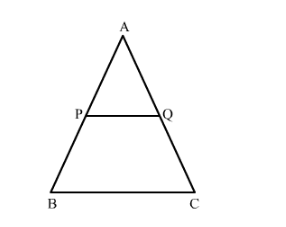In a ∆ABC, P and Q are points on sides AB and AC respectively, such that PQ || BC. If AP = 2.4 cm, AQ = 2 cm, QC = 3 cm and BC = 6 cm, find the AB and PQ

It is given that $A P=2.4 \mathrm{~cm}, A Q=2 \mathrm{~cm}, Q C=3 \mathrm{~cm}$ and $B C=6 \mathrm{~cm}$.
We have to find $A B$ and $P Q$.
So $\frac{A P}{P B}=\frac{A Q}{Q C}$ (by Thales theorem)
Then $\frac{2.4}{P B}=\frac{2}{3}$
$\Rightarrow 2 P B=2.4 \times 3 \mathrm{~cm}$
$\Rightarrow P B=\frac{2.4 \times 3}{2} \mathrm{~cm}$
$=3.6 \mathrm{~cm}$
Now
$A B=A P+P B$
$=2.4+3.6 \mathrm{~cm}$
$=6 \mathrm{~cm}$
Since PQ∥BC, AB is a transversal, then
∠APQ = ∠ABC (corresponding angles)
Since PQ∥BC, AC is a transversal, then
∠AQP = ∠ACB (corresponding angles)
In ∆APQ and ∆ABC,
∠APQ = ∠ABC (proved above)
∠AQP = ∠ACB (proved above)
so, ∆ APQ ∼ ∆ ABC (Angle Angle Similarity)
Since the corresponding sides of similar triangles are proportional, then
APAB = PQBC = AQAC
APAB = PQBC2.46 = PQ6so, PQ = 2.4 cm
Click here to get exam-ready with eSaral
For making your preparation journey smoother of JEE, NEET and Class 8 to 10, grab our app now.
